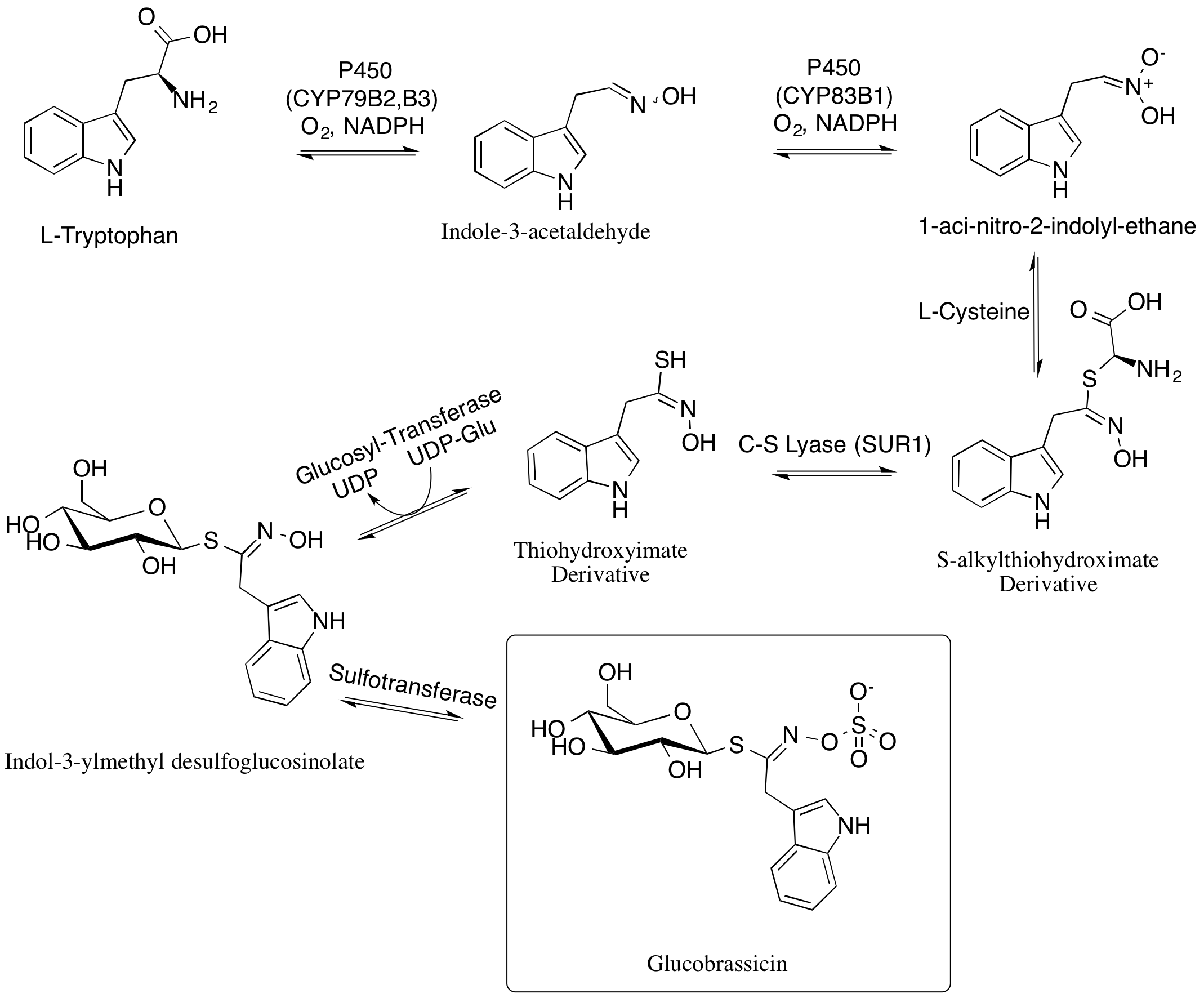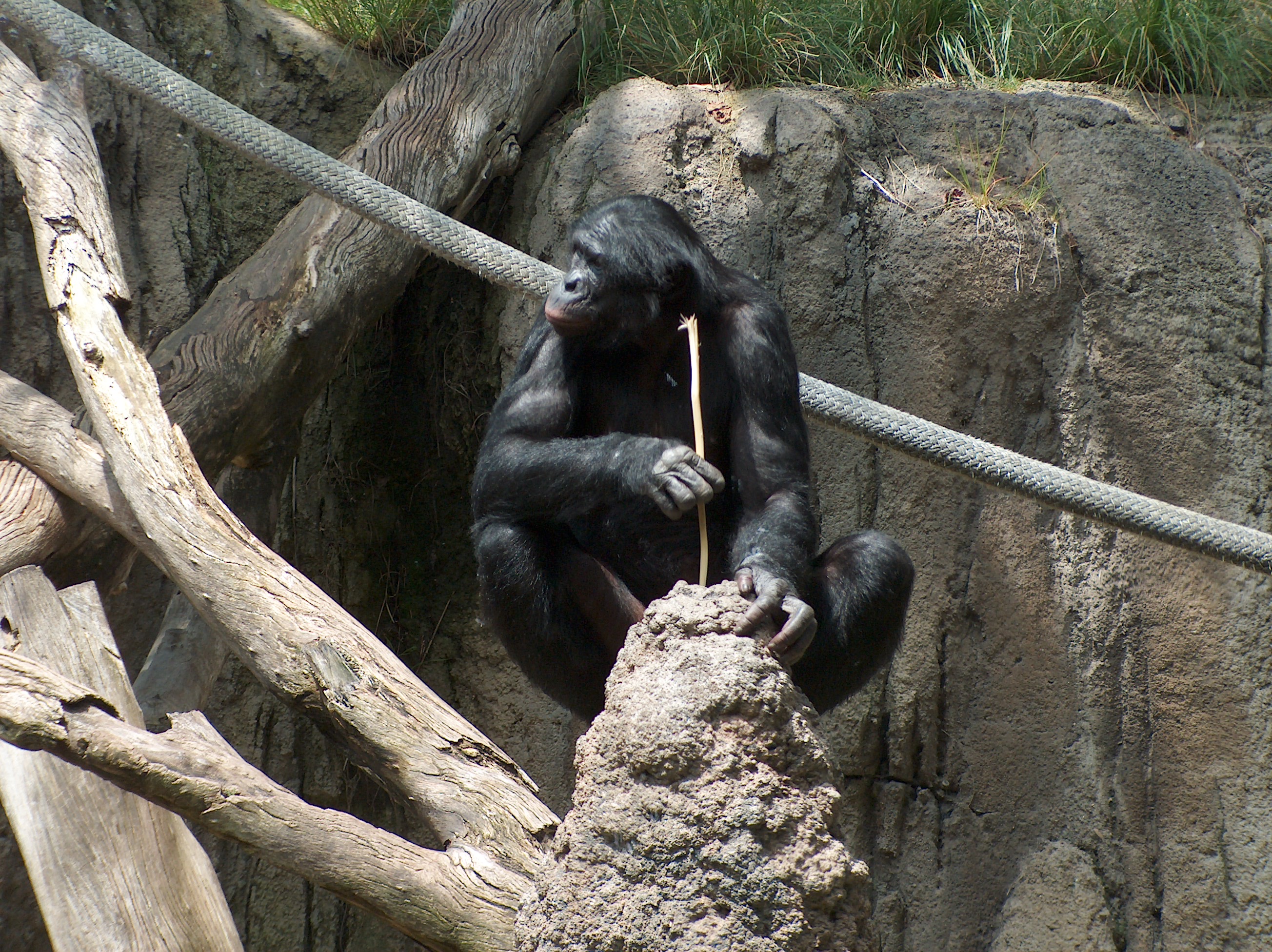|
Gluconasturtiin
Gluconasturtiin (phenethylglucosinolate) is one of the most widely distributed glucosinolates in the cruciferous vegetables, mainly in the roots, and is probably one of the plant compounds responsible for the natural pest-inhibiting properties of growing crucifers, such as cabbage, mustard or rape, in rotation with other crops. This effect of gluconasturtiin is most likely due to its degradation by the plant enzyme myrosinase into phenethyl isothiocyanate, which is toxic to many organisms. Gluconasturtiin is named from its occurrence in watercress (''Nasturtium officinale''). Among the vegetables, it is also found in horseradish (''Armoracia rusticana'') along with sinigrin. Both compounds elicit a pungent taste. In one investigation of horseradish roots, sinigrin concentration represented 83% and gluconasturtiin 11% of the extracted glucosinolates. XIAN LI, KUSHAD MM (2004) Correlation of glucosinolate content to myrosinase activity in horseradish (Armoracia rusticana).'' J Agr ... [...More Info...] [...Related Items...] OR: [Wikipedia] [Google] [Baidu] |
Glucosinolate
Glucosinolates are natural components of many pungent plants such as mustard, cabbage, and horseradish. The pungency of those plants is due to mustard oils produced from glucosinolates when the plant material is chewed, cut, or otherwise damaged. These natural chemicals most likely contribute to plant defence against pests and diseases, and impart a characteristic bitter flavor property to cruciferous vegetables. Plants with glucosinolates Glucosinolates occur as secondary metabolites of almost all plants of the order Brassicales. Ordered in the Brassicales are for example the economically important family Brassicaceae as well as Capparaceae and Caricaceae. Outside of the Brassicales, the genera ''Drypetes'' and '' Putranjiva'' in the family Putranjivaceae, are the only other known occurrence of glucosinolates. Glucosinolates occur in various edible plants such as cabbage (white cabbage, Chinese cabbage, broccoli), Brussels sprouts, watercress, horseradish, capers, and rad ... [...More Info...] [...Related Items...] OR: [Wikipedia] [Google] [Baidu] |
Sinigrin
Sinigrin is a glucosinolate that belongs to the family of glucosides found in some plants of the family Brassicaceae such as Brussels sprouts, broccoli, and the seeds of black mustard (''Brassica nigra''). Whenever sinigrin-containing plant tissue is crushed or otherwise damaged, the enzyme myrosinase degrades sinigrin to a mustard oil (allyl isothiocyanate), which is responsible for the pungent taste of mustard and horseradish. Seeds of white mustard, ''Sinapis alba'', will give a much less pungent mustard because this species contains a different glucosinolate, sinalbin. The chemical name of sinigrin is allylglucosinolate or 2-propenylglucosinolate. Sinigrin stereochemical configuration on the C=N double bond was for a time uncertain, and has been resolved by X-ray crystallography in 1963 to be the ''Z'' (or ''syn'') isomer. Singrin is also known to be allelopathic. See also * Allyl isothiocyanate * Gluconasturtiin * List of phytochemicals in food While there is ample ... [...More Info...] [...Related Items...] OR: [Wikipedia] [Google] [Baidu] |
Glucobrassicin
Glucobrassicin is a type of glucosinolate that can be found in almost all cruciferous plants, such as cabbages, broccoli, mustards, and woad. As for other glucosinolates, degradation by the enzyme myrosinase is expected to produce an isothiocyanate, indol-3-ylmethylisothiocyanate. However, this specific isothiocyanate is expected to be highly unstable, and has indeed never been detected. The observed hydrolysis products when isolated glucobrassicin is degraded by myrosinase are indole-3-carbinol and thiocyanate ion (plus glucose, sulfate, and hydrogen ion), which are envisioned to result from a rapid reaction of the unstable isothiocyanate with water. However, a large number of other reaction products are known, and indole-3-carbinol is not the dominant degradation product when glucosinolate degradation takes place in crushed plant tissue or in intact plants. Glucobrassicin is also known to be a highly active egg-laying stimulant of cabbage white butterflies such as the small ... [...More Info...] [...Related Items...] OR: [Wikipedia] [Google] [Baidu] |
Cruciferous Vegetables
Cruciferous vegetables are vegetables of the family Brassicaceae (also called Cruciferae) with many genera, species, and cultivars being raised for food production such as cauliflower, cabbage, kale, garden cress, bok choy, broccoli, Brussels sprouts, mustard plant and similar green leaf vegetables. The family takes its alternative name (Cruciferae, New Latin for "cross-bearing") from the shape of their flowers, whose four petals resemble a cross. Ten of the most common cruciferous vegetables eaten by people, known colloquially in North America as cole crops and in the UK, Ireland and Australia as brassicas, are in a single species (''Brassica oleracea''); they are not distinguished from one another taxonomically, only by horticultural category of cultivar groups. Numerous other genera and species in the family are also edible. Cruciferous vegetables are one of the dominant food crops worldwide. They are high in vitamin C and soluble fiber and contain multiple nutrients and ... [...More Info...] [...Related Items...] OR: [Wikipedia] [Google] [Baidu] |
Myrosinase
Myrosinase (, ''thioglucoside glucohydrolase'', ''sinigrinase'', and ''sinigrase'') is a family of enzymes involved in plant defense against herbivores, specifically the mustard oil bomb. The three-dimensional structure has been elucidated and is available in the PDB (see links in the infobox). A member of the glycoside hydrolase family, myrosinase possesses several similarities with the more ubiquitous O- glycosidases. However, myrosinase is the only known enzyme found in nature that can cleave a thio-linked glucose. Its known biological function is to catalyze the hydrolysis of a class of compounds called glucosinolates. Myrosinase activity Myrosinase is regarded as a defense-related enzyme and is capable of hydrolyzing glucosinolates into various compounds, some of which are toxic. Mechanism Myrosinase catalyzes the chemical reaction :a thioglucoside + H2O \rightleftharpoons a sugar + a thiol Thus, the two substrates of this enzyme are thioglucoside and H2O, whereas ... [...More Info...] [...Related Items...] OR: [Wikipedia] [Google] [Baidu] |
Phenethyl Isothiocyanate
Phenethyl isothiocyanate (PEITC) is a naturally occurring isothiocyanate whose precursor, gluconasturtiin is found in some cruciferous vegetables, especially watercress. PEITC has been studied for its potential for chemoprevention of cancers, such as prostate cancer. In terms of biosynthesis, PEITC is produced from gluconasturtiin by the action of the enzyme myrosinase Myrosinase (, ''thioglucoside glucohydrolase'', ''sinigrinase'', and ''sinigrase'') is a family of enzymes involved in plant defense against herbivores, specifically the mustard oil bomb. The three-dimensional structure has been elucidated and is .... References Isothiocyanates {{Cruciferous Biochemistry ... [...More Info...] [...Related Items...] OR: [Wikipedia] [Google] [Baidu] |
Watercress
Watercress or yellowcress (''Nasturtium officinale'') is a species of aquatic flowering plant in the cabbage family Brassicaceae. Watercress is a rapidly growing perennial plant native to Europe and Asia. It is one of the oldest known leaf vegetables consumed by humans. Watercress and many of its relatives, such as garden cress, mustard, radish, and wasabi, are noteworthy for their piquant flavors. The hollow stems of watercress float in water. The leaf structure is pinnately compound. Small, white, and green inflorescences are produced in clusters and are frequently visited by insects, especially hoverflies, such as '' Eristalis'' flies. Taxonomy Watercress is listed in some sources as belonging to the genus '' Rorippa'', although molecular evidence shows those aquatic species with hollow stems are more closely related to '' Cardamine'' than ''Rorippa''. Despite the Latin name, watercress is not particularly closely related to the flowers popularly known as nasturtiums (' ... [...More Info...] [...Related Items...] OR: [Wikipedia] [Google] [Baidu] |
Horseradish
Horseradish (''Armoracia rusticana'', syn. ''Cochlearia armoracia'') is a perennial plant of the family Brassicaceae (which also includes mustard, wasabi, broccoli, cabbage, and radish). It is a root vegetable, cultivated and used worldwide as a spice and as a condiment. The species is probably native to southeastern Europe and western Asia. Description Horseradish grows up to tall, with hairless bright green unlobed leaves up to long that may be mistaken for docks (''Rumex''). It is cultivated primarily for its large, white, tapered root. The white four-petalled flowers are scented and are borne in dense panicles. Established plants may form extensive patches and may become invasive unless carefully managed. Intact horseradish root has little aroma. When cut or grated, enzymes from within the plant cells digest sinigrin (a glucosinolate) to produce allyl isothiocyanate ( mustard oil), which irritates the mucous membranes of the sinuses and eyes. Once exposed to air ... [...More Info...] [...Related Items...] OR: [Wikipedia] [Google] [Baidu] |
Pungent
Pungency () refers to the taste of food commonly referred to as spiciness, hotness or heat, found in foods such as chili peppers. Highly pungent tastes may be experienced as unpleasant. The term piquancy () is sometimes applied to foods with a lower degree of pungency that are "agreeably stimulating to the palate". Examples of piquant food include mustard and curry. Terminology In colloquial speech, the term "pungency" can refer to any strong, sharp smell or flavor. However, in scientific speech, it refers specifically to the "hot" or "spicy" quality of chili peppers. It is the preferred term by scientists as it eliminates the potential ambiguity arising from use of "hot" and "spicy", which can also refer to temperature or the presence of spices, respectively. For instance, a pumpkin pie can be both hot (out of the oven) and spicy (due to the common inclusion of spices such as cinnamon, nutmeg, allspice, mace, and cloves), but it is not ''pungent''. (A food critic may neverthel ... [...More Info...] [...Related Items...] OR: [Wikipedia] [Google] [Baidu] |
Journal Of Agricultural And Food Chemistry
The ''Journal of Agricultural and Food Chemistry'' is a weekly peer-reviewed scientific journal established in 1953 by the American Chemical Society. Since 2015, Thomas Hofmann (Technical University of Munich) has been the editor-in-chief. The journal covers research dealing with the chemistry and biochemistry of agriculture and food including work with chemistry and/or biochemistry as a major component combined with biological/sensory/nutritional/toxicological evaluation related to agriculture and/or food. Abstracting and indexing The journal is abstracted and indexed in Chemical Abstracts Service, Scopus, ProQuest, PubMed, CABI, and the Science Citation Index Expanded. According to the ''Journal Citation Reports'', the ''Journal of Agricultural and Food Chemistry'' has a 2015 impact factor The impact factor (IF) or journal impact factor (JIF) of an academic journal is a scientometric index calculated by Clarivate that reflects the yearly mean number of citations of artic ... [...More Info...] [...Related Items...] OR: [Wikipedia] [Google] [Baidu] |
Pungent Flavors
Pungency () refers to the taste of food commonly referred to as spiciness, hotness or heat, found in foods such as chili peppers. Highly pungent tastes may be experienced as unpleasant. The term piquancy () is sometimes applied to foods with a lower degree of pungency that are "agreeably stimulating to the palate". Examples of piquant food include mustard and curry. Terminology In colloquial speech, the term "pungency" can refer to any strong, sharp smell or flavor. However, in scientific speech, it refers specifically to the "hot" or "spicy" quality of chili peppers. It is the preferred term by scientists as it eliminates the potential ambiguity arising from use of "hot" and "spicy", which can also refer to temperature or the presence of spices, respectively. For instance, a pumpkin pie can be both hot (out of the oven) and spicy (due to the common inclusion of spices such as cinnamon, nutmeg, allspice, mace, and cloves), but it is not ''pungent''. (A food critic may neverth ... [...More Info...] [...Related Items...] OR: [Wikipedia] [Google] [Baidu] |
Nutrition
Nutrition is the biochemical and physiological process by which an organism uses food to support its life. It provides organisms with nutrients, which can be metabolized to create energy and chemical structures. Failure to obtain sufficient nutrients causes malnutrition. Nutritional science is the study of nutrition, though it typically emphasizes human nutrition. The type of organism determines what nutrients it needs and how it obtains them. Organisms obtain nutrients by consuming organic matter, consuming inorganic matter, absorbing light, or some combination of these. Some can produce nutrients internally by consuming basic elements, while some must consume other organisms to obtain preexisting nutrients. All forms of life require carbon, energy, and water as well as various other molecules. Animals require complex nutrients such as carbohydrates, lipids, and proteins, obtaining them by consuming other organisms. Humans have developed agriculture and cooking to rep ... [...More Info...] [...Related Items...] OR: [Wikipedia] [Google] [Baidu] |






